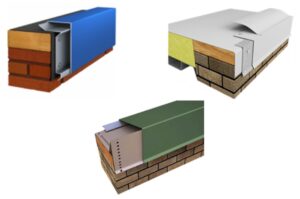What is a Roof Scupper?
A roof scupper is a type of drainage system that allows water to flow off a flat or low-sloped roof. Scuppers are typically located near the edges of the roof, and designed to direct water away from the building. Roof scuppers prevent water from pooling on the roof and causing costly damage to your roof membrane. They can be made of metal and are often incorporated into the design of a building’s façade or parapet walls. They often drain into downspouts to make sure water drains away from the building. In addition to their function as a drainage system, roof scuppers can also serve as a decorative element in a building’s design.
Benefits of a Roof Scupper
A roof scupper is an important part of any roofing system and provides many benefits. Firstly, it is a simple, affordable, and effective way to drain water off your roof. Secondly, roof scuppers prevent water ponding that causes damage to your roof membrane. Especially when paired with tapered insulation and roof crickets. Thirdly, properly placed scuppers provide great drainage on large commercial buildings where lots of rain can need to be drained very quickly. They also provide a great emergency backup for a primary drain system if it gets clogged. Lastly, you don’t have to run drainage pipes into your building with a scupper system. Running drain pipes inside raises the cost of installation and increases the chances of indoor leaks and water damage.
What Kind of Maintenance do Scuppers Need?
Like any type of drainage system, scuppers require regular maintenance to ensure that they are functioning properly. Some common maintenance tasks that may be necessary for scuppers include:
- Cleaning: Scuppers, like roof drains, can become clogged with debris such as leaves, twigs, and other materials. The debris prevents water from flowing through them properly and allows water to pool on the roof. It is important to regularly clean all types of roof drains to remove blockages and ensure effective roof drainage. Cleaning the metal can also prevent rusty scuppers that will deteriorate and need to be replaced.
- Inspecting for Damage: Scuppers can become damaged over time due to weather, wear and tear, or other factors. It is important to periodically inspect them for signs of damage, such as cracks, holes, and/or rust, and repair or replace them as needed.
- Checking for Proper Drainage: Scuppers should be checked regularly to ensure that they are directing water away from the building as intended. If water is not flowing properly, it could be a sign that there is a problem with the drainage system that needs to be addressed. Damp spots near the base of the building can be sign of improper roof drainage.
- Maintaining the Surrounding Area: It is important to maintain the area around scuppers to ensure that they are not obstructed by debris or other materials that may prevent water from flowing to the scuppers and away from the building. This can include regularly cleaning the roof and removing any debris. These maintenance items should be taken care of by your roofing contractors preventative maintenance plan (PMP), if you have one.

Roof with undersized scupper and improperly installed crickets
Can You Add Scuppers after a Roof is Put On?
It is possible to add scuppers to a roof after it has been installed, but it is a complex process that requires the expertise of a trained flat roofing contractor. Adding scuppers to an existing roof typically involves cutting openings in the roof and installing the scuppers in these openings. This can be a challenging task depending on the construction of the roof and the location of the scuppers. Additionally, it may be necessary to make additional modifications to the roof or the building’s drainage system to accommodate the new addition. Because of the complexity of this process, it is generally best to consult with a professional roofing contractor and/or engineer if you are considering adding scuppers to an existing roof. They can assess the feasibility of the project and provide guidance on the best way to proceed.
What are Alternatives to Scuppers?
There are several alternatives to scuppers that can be used to drain water off a flat or low-sloped commercial roof. Some common alternatives include:
- Roof drains: Roof drains drain water off a roof, but they are typically located in the center of the roof rather than at the edges. Roof drains can be more effective at draining large volumes of water than scuppers, especially if the roof is not sloped enough to allow water to flow towards the edges.
- Gutters: Gutters are a type of drainage system that is commonly used on pitched roofs, but can also be used on flat or low-sloped roofs too. Gutters are installed along the edges of the roof and are designed to collect and channel water away from the building.
- Internal drainage systems: Some buildings have internal drainage systems that are designed to collect and channel water away from the building’s structure. These systems can be more effective at preventing water damage than external drainage systems, as they can be used to drain water away from areas that are not visible from the outside of the building.
Conclusion
In Conclusion, roof scuppers are a great option for commercial roofs. With proper installation and maintenance, they can keep your roof lasting its full expected life-time. However, damaged, clogged, or rusted scuppers, will put your roof at risk of membrane damage and water leaks into your building. Contact your local commercial roofing contractor to make sure your roof drainage system is working properly today.



